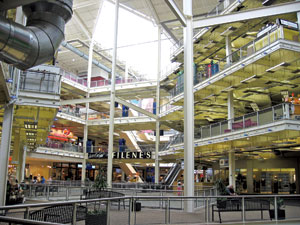Trending
The malls are all right
<i>Economic downturn, but things still look good from center court</i>

The Palisades CenterThe frenzy of the holiday shopping season is winding down, but malls across the region don’t expect a holiday hangover.
Mall leasing was up 38 percent in 2010 nationally, and rents were about 14 percent higher, according to the International Council of Shopping Centers. Sales jumped 7 percent in September from the prior year.
The ICSC estimates that the 1,200 indoor malls nationwide generate an average of close to $400 per square foot in sales volume, and brokers say the number in the New York tri-state area at high-end malls is more like $800 a square foot. And some even have waiting lists of stores looking to take space.
One retail broker — who has clients in several of these regional shopping centers and spoke on condition of anonymity — said that the Mall at Short Hills in New Jersey is probably approaching close to $1,000 per square foot in sales volume, if not more. Roosevelt Field on Long Island is not far behind, with sales exceeding $900 per square foot, the broker said. On the lower end is the Stamford Town Center in Connecticut, which pulls in $450 of revenue per square foot, and the Palisades Center, at $525, though those figures are still higher than the national average. Most representatives for regional malls declined to talk in detail about rents and turnover.
Still, many of these tri-state shopping centers experienced low moments during the downturn, brokers say. Several were “retenanted,” meaning struggling retailers closed down and new ones moved in.
“During the downturn, these malls did have some vacancies, but far fewer than you would have seen in average malls across the country,” said Josh Podell, president of Podell Real Estate Advisors, based in New York, and former vice president of real estate for Jones Apparel Group.
Robin Abrams, executive vice president at the Lansco Corp., said New York’s density means a lot of foot traffic for regional malls.
Some companies — specifically international brands — choose to enter the New York market before they roll out nationally. “They will introduce their brands to malls like the Westchester, Roosevelt Field, Garden State Plaza,” Abrams said, noting that they will often open a mall location in the metro area in conjunction with street locations in the city.
Phil Genovese, the senior vice president of leasing at the Garden State Plaza, said last month that the Paramus shopping center would be 99 percent occupied by the end of 2010. Thirty-five new tenants opened there in 2009, he said, including Game Stop and LensCrafters, following a major mall expansion. “We’re doing very well, and we’ve had 12 months of consecutive increases,” Genovese said.
Podell, meanwhile, estimated that Roosevelt Field, the Westchester and Short Hills are at or very close to 100 percent occupancy. Other malls, like the Staten Island Mall, the Shops at Riverside and the Stamford Town Center, “have been in the process of remerchandising over the past several years,” Podell noted, and are probably close to 90 percent leased.
At Riverside, marketing director Lisa Polino said she is “definitely seeing an upswing” in retail leasing. While the mall, located in Hackensack, only had two new stores open in 2009, she recently said she expected five new retailers by the end of 2010, including H & M, Brighton Collectibles, a Toys “R” Us Express holiday store and Omega, which would be the boutique’s first New Jersey location.
The average mall rent for non-anchor tenants across the country is close to $38 per square foot, but higher-end malls in New York and New Jersey are often above that, sometimes more than double, though their costs are often higher as well, said Faith Hope Consolo, chairman of retail leasing at Prudential Douglas Elliman.
The most expensive rates in the region are at Short Hills, where they reach $150 per square foot for a small space. (Retailers also pay CAM charges — for common area maintenance, insurance and real estate taxes — that vary by mall.)
At Garden State, a 2,000- to 3,000-square-foot space, depending on location and layout, might rent for $80 to $85 a square foot for a typical apparel shop, said one broker who asked to remain anonymous. The broker is looking for a space of a few thousand feet for an upscale European apparel store.
At Riverside, retail tenants pay from $60 to $70 a square foot, while Roosevelt Field asks for close to $80 a square foot, estimated the broker, who has worked with retailers to lease mall locations in the past.
The resiliency of these malls stems, in part, from the musical chairs among retailers during the downturn.
Some are expanding, like H & M, Forever 21, Urban Outfitters, AT & T and Best Buy, according to Consolo. Others are downsizing, said Podell, like Abercrombie & Fitch, American Eagle and Bebe Sport. Bailey Banks & Biddle, Eddie Bauer and Zale’s are scaling back as well, Consolo added. Still others, like Loehmann’s, have declared bankruptcy.
But as soon as one door closes, another opens. Podell, who works with tenants that lease space at Roosevelt Field, said that Bebe Sport was being replaced at the Garden City mall on Long Island, possibly by a high-end denim retailer. Ruehl, from Abercrombie & Fitch, was replaced by Nike, which was “a big deal for [last] year,” he noted. New tenants also opening there include Six and Accessorize, two accessory stores. And the former Sephora space there is now occupied by a Square 1 temp store, he said.
“These malls are in the fortunate position of having waiting lists of tenants that want to get in, so when they have something vacant, they can talk to appropriate tenants and lock them in,” Abrams added.




